2010 Alfa Romeo Brera/Spider engine
[x] Cancel search: enginePage 104 of 271
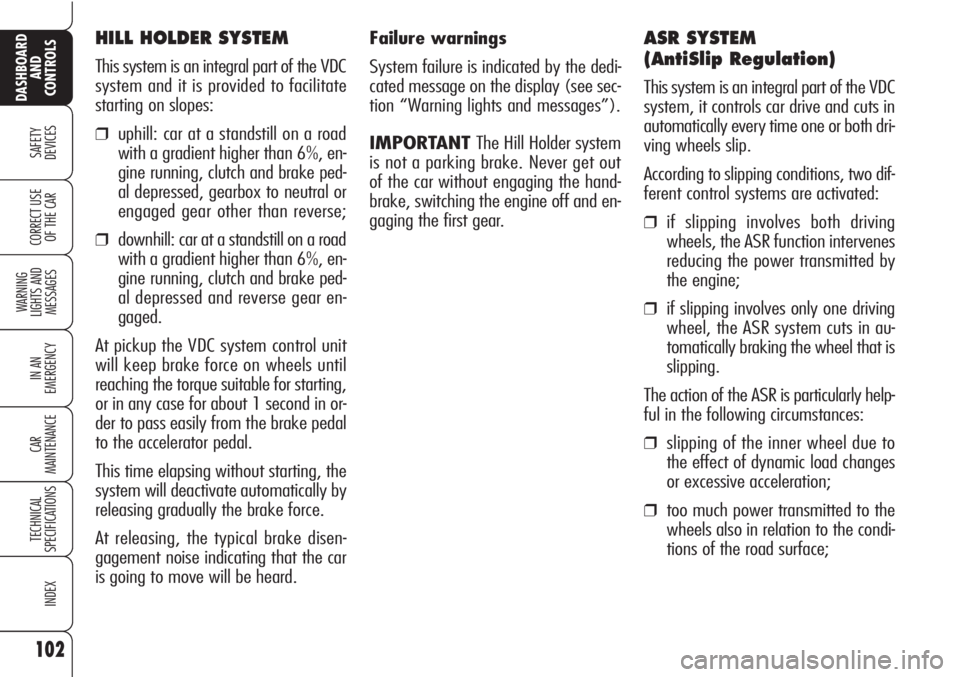
102
SAFETY
DEVICES
WARNING
LIGHTS AND
MESSAGES
IN AN
EMERGENCY
CAR
MAINTENANCE
TECHNICAL
SPECIFICATIONS
INDEX
DASHBOARD
AND
CONTROLS
CORRECT USE
OF THE CAR
HILL HOLDER SYSTEM
This system is an integral part of the VDC
system and it is provided to facilitate
starting on slopes:
❒uphill: car at a standstill on a road
with a gradient higher than 6%, en-
gine running, clutch and brake ped-
al depressed, gearbox to neutral or
engaged gear other than reverse;
❒downhill: car at a standstill on a road
with a gradient higher than 6%, en-
gine running, clutch and brake ped-
al depressed and reverse gear en-
gaged.
At pickup the VDC system control unit
will keep brake force on wheels until
reaching the torque suitable for starting,
or in any case for about 1 second in or-
der to pass easily from the brake pedal
to the accelerator pedal.
This time elapsing without starting, the
system will deactivate automatically by
releasing gradually the brake force.
At releasing, the typical brake disen-
gagement noise indicating that the car
is going to move will be heard.Failure warnings
System failure is indicated by the dedi-
cated message on the display (see sec-
tion “Warning lights and messages”).
IMPORTANT The Hill Holder system
is not a parking brake. Never get out
of the car without engaging the hand-
brake, switching the engine off and en-
gaging the first gear.
ASR SYSTEM
(AntiSlip Regulation)
This system is an integral part of the VDC
system, it controls car drive and cuts in
automatically every time one or both dri-
ving wheels slip.
According to slipping conditions, two dif-
ferent control systems are activated:
❒if slipping involves both driving
wheels, the ASR function intervenes
reducing the power transmitted by
the engine;
❒if slipping involves only one driving
wheel, the ASR system cuts in au-
tomatically braking the wheel that is
slipping.
The action of the ASR is particularly help-
ful in the following circumstances:
❒slipping of the inner wheel due to
the effect of dynamic load changes
or excessive acceleration;
❒too much power transmitted to the
wheels also in relation to the condi-
tions of the road surface;
Page 105 of 271
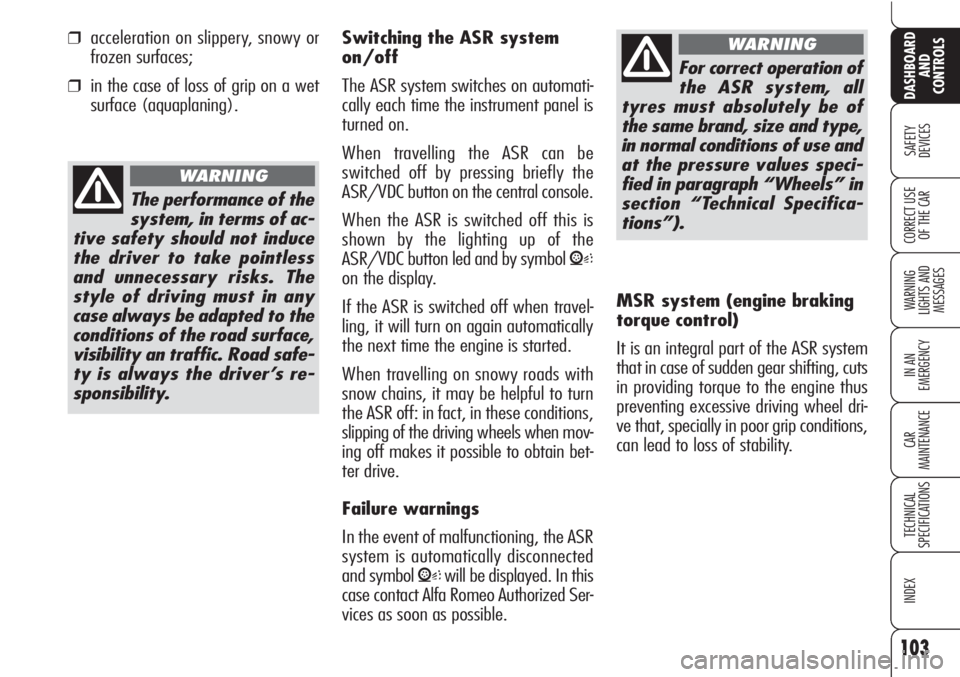
103
SAFETY
DEVICES
WARNING
LIGHTS AND
MESSAGES
IN AN
EMERGENCY
CAR
MAINTENANCE
TECHNICAL
SPECIFICATIONS
INDEX
DASHBOARD
AND
CONTROLS
CORRECT USE
OF THE CAR
❒acceleration on slippery, snowy or
frozen surfaces;
❒in the case of loss of grip on a wet
surface (aquaplaning).
The performance of the
system, in terms of ac-
tive safety should not induce
the driver to take pointless
and unnecessary risks. The
style of driving must in any
case always be adapted to the
conditions of the road surface,
visibility an traffic. Road safe-
ty is always the driver’s re-
sponsibility.
WARNING
Switching the ASR system
on/off
The ASR system switches on automati-
cally each time the instrument panel is
turned on.
When travelling the ASR can be
switched off by pressing briefly the
ASR/VDC button on the central console.
When the ASR is switched off this is
shown by the lighting up of the
ASR/VDC button led and by symbol
V
on the display.
If the ASR is switched off when travel-
ling, it will turn on again automatically
the next time the engine is started.
When travelling on snowy roads with
snow chains, it may be helpful to turn
the ASR off: in fact, in these conditions,
slipping of the driving wheels when mov-
ing off makes it possible to obtain bet-
ter drive.
Failure warnings
In the event of malfunctioning, the ASR
system is automatically disconnected
and symbol
Vwill be displayed. In this
case contact Alfa Romeo Authorized Ser-
vices as soon as possible.
For correct operation of
the ASR system, all
tyres must absolutely be of
the same brand, size and type,
in normal conditions of use and
at the pressure values speci-
fied in paragraph “Wheels” in
section “Technical Specifica-
tions”).
WARNING
MSR system (engine braking
torque control)
It is an integral part of the ASR system
that in case of sudden gear shifting, cuts
in providing torque to the engine thus
preventing excessive driving wheel dri-
ve that, specially in poor grip conditions,
can lead to loss of stability.
Page 106 of 271
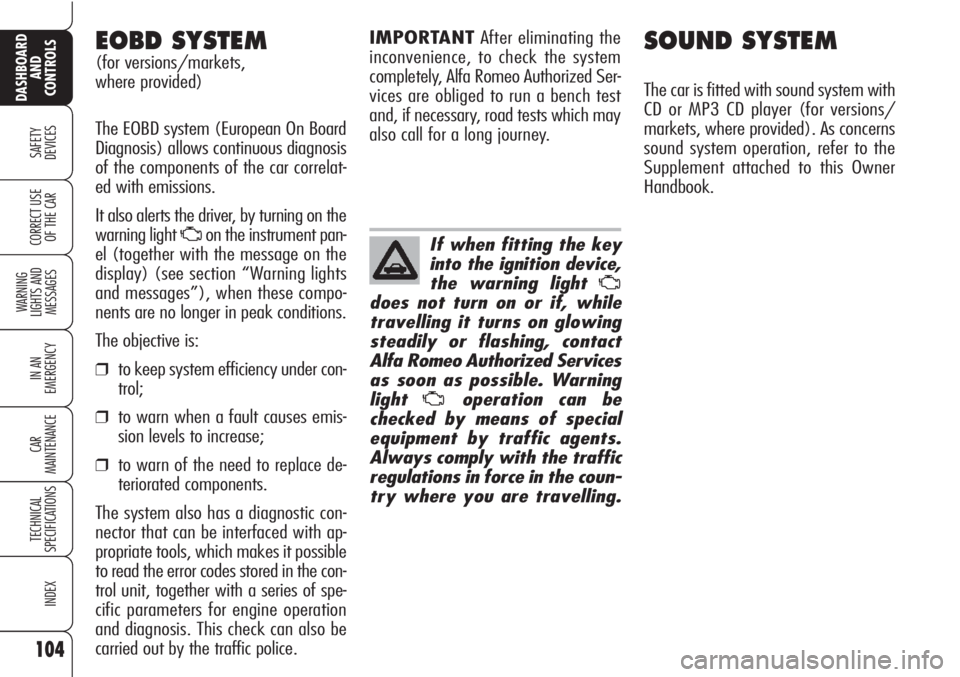
104
SAFETY
DEVICES
WARNING
LIGHTS AND
MESSAGES
IN AN
EMERGENCY
CAR
MAINTENANCE
TECHNICAL
SPECIFICATIONS
INDEX
DASHBOARD
AND
CONTROLS
CORRECT USE
OF THE CAR
SOUND SYSTEM
The car is fitted with sound system with
CD or MP3 CD player (for versions/
markets, where provided). As concerns
sound system operation, refer to the
Supplement attached to this Owner
Handbook.
EOBD SYSTEM
(for versions/markets,
where provided)
The EOBD system (European On Board
Diagnosis) allows continuous diagnosis
of the components of the car correlat-
ed with emissions.
It also alerts the driver, by turning on the
warning light
Uon the instrument pan-
el (together with the message on the
display) (see section “Warning lights
and messages”), when these compo-
nents are no longer in peak conditions.
The objective is:
❒to keep system efficiency under con-
trol;
❒to warn when a fault causes emis-
sion levels to increase;
❒to warn of the need to replace de-
teriorated components.
The system also has a diagnostic con-
nector that can be interfaced with ap-
propriate tools, which makes it possible
to read the error codes stored in the con-
trol unit, together with a series of spe-
cific parameters for engine operation
and diagnosis. This check can also be
carried out by the traffic police.
If when fitting the key
into the ignition device,
the warning light
U
does not turn on or if, while
travelling it turns on glowing
steadily or flashing, contact
Alfa Romeo Authorized Services
as soon as possible. Warning
light
Uoperation can be
checked by means of special
equipment by traffic agents.
Always comply with the traffic
regulations in force in the coun-
try where you are travelling.
IMPORTANTAfter eliminating the
inconvenience, to check the system
completely, Alfa Romeo Authorized Ser-
vices are obliged to run a bench test
and, if necessary, road tests which may
also call for a long journey.
Page 110 of 271
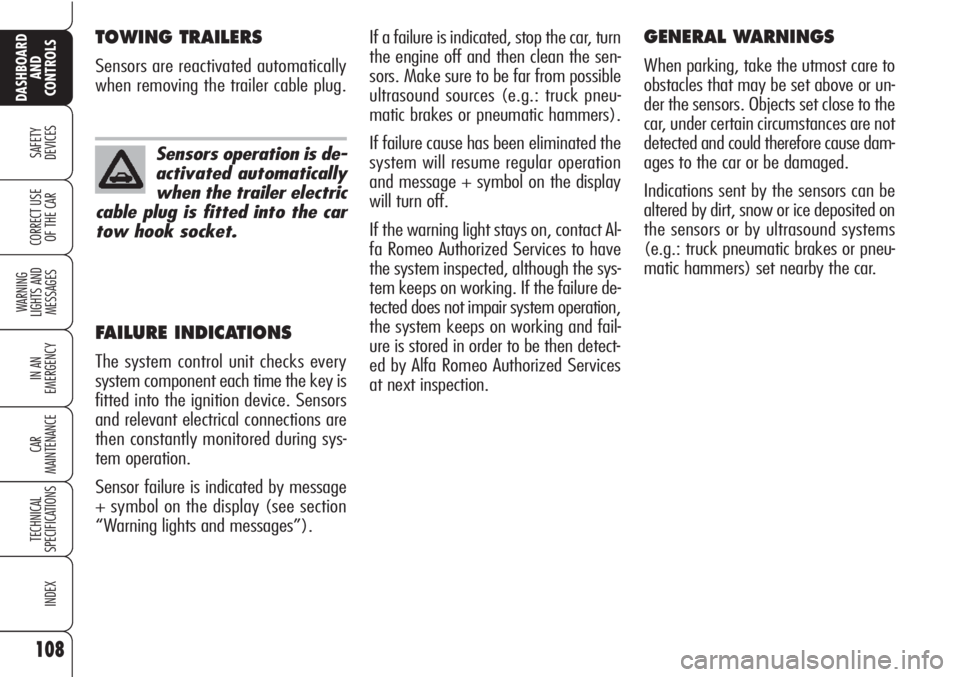
108
SAFETY
DEVICES
WARNING
LIGHTS AND
MESSAGES
IN AN
EMERGENCY
CAR
MAINTENANCE
TECHNICAL
SPECIFICATIONS
INDEX
DASHBOARD
AND
CONTROLS
CORRECT USE
OF THE CAR
If a failure is indicated, stop the car, turn
the engine off and then clean the sen-
sors. Make sure to be far from possible
ultrasound sources (e.g.: truck pneu-
matic brakes or pneumatic hammers).
If failure cause has been eliminated the
system will resume regular operation
and message + symbol on the display
will turn off.
If the warning light stays on, contact Al-
fa Romeo Authorized Services to have
the system inspected, although the sys-
tem keeps on working. If the failure de-
tected does not impair system operation,
the system keeps on working and fail-
ure is stored in order to be then detect-
ed by Alfa Romeo Authorized Services
at next inspection.GENERAL WARNINGS
When parking, take the utmost care to
obstacles that may be set above or un-
der the sensors. Objects set close to the
car, under certain circumstances are not
detected and could therefore cause dam-
ages to the car or be damaged.
Indications sent by the sensors can be
altered by dirt, snow or ice deposited on
the sensors or by ultrasound systems
(e.g.: truck pneumatic brakes or pneu-
matic hammers) set nearby the car.
TOWING TRAILERS
Sensors are reactivated automatically
when removing the trailer cable plug.
FAILURE INDICATIONS
The system control unit checks every
system component each time the key is
fitted into the ignition device. Sensors
and relevant electrical connections are
then constantly monitored during sys-
tem operation.
Sensor failure is indicated by message
+ symbol on the display (see section
“Warning lights and messages”).
Sensors operation is de-
activated automatically
when the trailer electric
cable plug is fitted into the car
tow hook socket.
Page 111 of 271
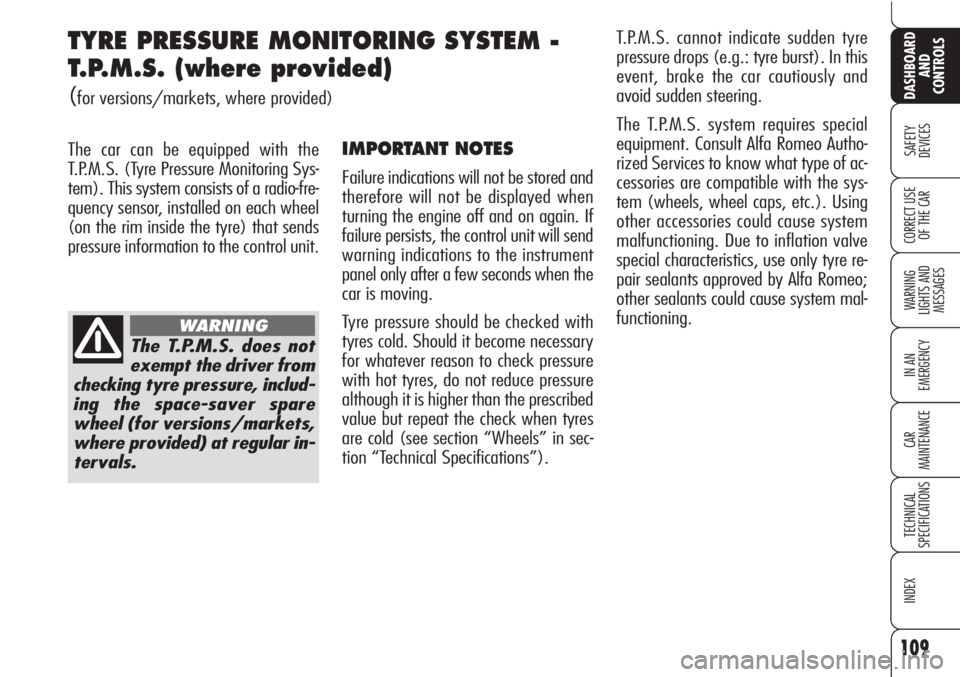
109
SAFETY
DEVICES
WARNING
LIGHTS AND
MESSAGES
IN AN
EMERGENCY
CAR
MAINTENANCE
TECHNICAL
SPECIFICATIONS
INDEX
DASHBOARD
AND
CONTROLS
CORRECT USE
OF THE CAR
TYRE PRESSURE MONITORING SYSTEM -
T.P.M.S. (where provided)
(for versions/markets, where provided)
The car can be equipped with the
T.P.M.S. (Tyre Pressure Monitoring Sys-
tem). This system consists of a radio-fre-
quency sensor, installed on each wheel
(on the rim inside the tyre) that sends
pressure information to the control unit.
IMPORTANT NOTES
Failure indications will not be stored and
therefore will not be displayed when
turning the engine off and on again. If
failure persists, the control unit will send
warning indications to the instrument
panel only after a few seconds when the
car is moving.
Tyre pressure should be checked with
tyres cold. Should it become necessary
for whatever reason to check pressure
with hot tyres, do not reduce pressure
although it is higher than the prescribed
value but repeat the check when tyres
are cold (see section “Wheels” in sec-
tion “Technical Specifications”).T.P.M.S. cannot indicate sudden tyre
pressure drops (e.g.: tyre burst). In this
event, brake the car cautiously and
avoid sudden steering.
The T.P.M.S. system requires special
equipment. Consult Alfa Romeo Autho-
rized Services to know what type of ac-
cessories are compatible with the sys-
tem (wheels, wheel caps, etc.). Using
other accessories could cause system
malfunctioning. Due to inflation valve
special characteristics, use only tyre re-
pair sealants approved by Alfa Romeo;
other sealants could cause system mal-
functioning.
The T.P.M.S. does not
exempt the driver from
checking tyre pressure, includ-
ing the space-saver spare
wheel (for versions/markets,
where provided) at regular in-
tervals.
WARNING
Page 114 of 271
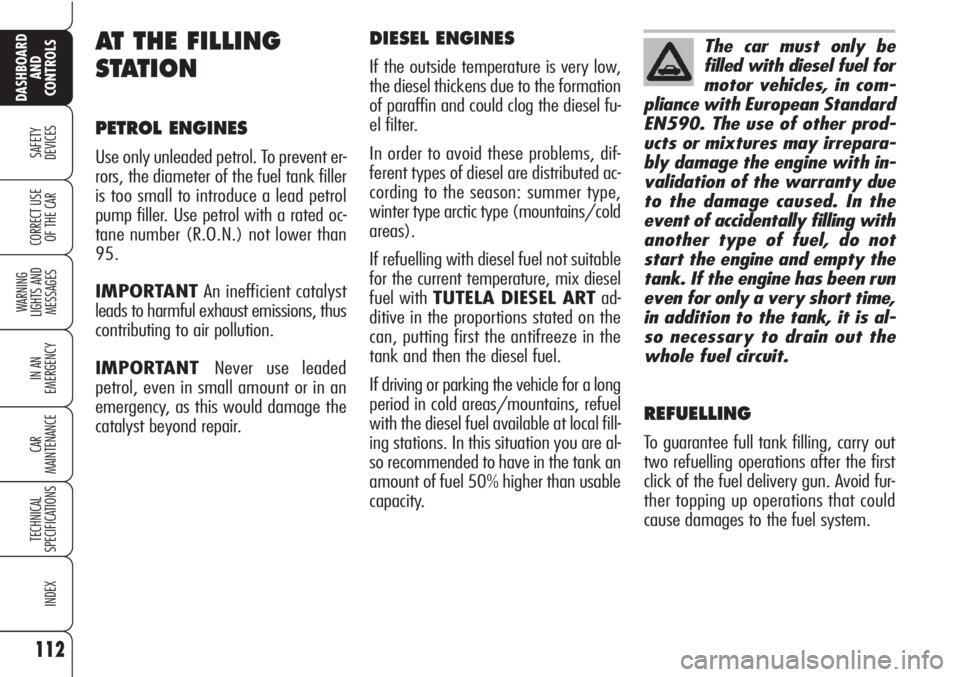
112
SAFETY
DEVICES
WARNING
LIGHTS AND
MESSAGES
IN AN
EMERGENCY
CAR
MAINTENANCE
TECHNICAL
SPECIFICATIONS
INDEX
DASHBOARD
AND
CONTROLS
CORRECT USE
OF THE CAR
DIESEL ENGINES
If the outside temperature is very low,
the diesel thickens due to the formation
of paraffin and could clog the diesel fu-
el filter.
In order to avoid these problems, dif-
ferent types of diesel are distributed ac-
cording to the season: summer type,
winter type arctic type (mountains/cold
areas).
If refuelling with diesel fuel not suitable
for the current temperature, mix diesel
fuel with TUTELA DIESEL ARTad-
ditive in the proportions stated on the
can, putting first the antifreeze in the
tank and then the diesel fuel.
If driving or parking the vehicle for a long
period in cold areas/mountains, refuel
with the diesel fuel available at local fill-
ing stations. In this situation you are al-
so recommended to have in the tank an
amount of fuel 50% higher than usable
capacity.
AT THE FILLING
STATION
PETROL ENGINES
Use only unleaded petrol. To prevent er-
rors, the diameter of the fuel tank filler
is too small to introduce a lead petrol
pump filler. Use petrol with a rated oc-
tane number (R.O.N.) not lower than
95.
IMPORTANTAn inefficient catalyst
leads to harmful exhaust emissions, thus
contributing to air pollution.
IMPORTANT Never use leaded
petrol, even in small amount or in an
emergency, as this would damage the
catalyst beyond repair.
The car must only be
filled with diesel fuel for
motor vehicles, in com-
pliance with European Standard
EN590. The use of other prod-
ucts or mixtures may irrepara-
bly damage the engine with in-
validation of the warranty due
to the damage caused. In the
event of accidentally filling with
another type of fuel, do not
start the engine and empty the
tank. If the engine has been run
even for only a very short time,
in addition to the tank, it is al-
so necessary to drain out the
whole fuel circuit.
REFUELLING
To guarantee full tank filling, carry out
two refuelling operations after the first
click of the fuel delivery gun. Avoid fur-
ther topping up operations that could
cause damages to the fuel system.
Page 115 of 271

113
SAFETY
DEVICES
WARNING
LIGHTS AND
MESSAGES
IN AN
EMERGENCY
CAR
MAINTENANCE
TECHNICAL
SPECIFICATIONS
INDEX
DASHBOARD
AND
CONTROLS
CORRECT USE
OF THE CAREMERGENCY OPENING
OF THE FUEL FILLER CAP
In case of failure, the fuel filler cap can
be opened by pulling string set on the
right side of the boot fig. 88.
A0F0130mfig. 88
FUEL FILLER CAP
The fuel tank lid can only be opened
with doors unlocked and engine
switched off.
Opening
Open the flap A-fig. 87by means of
front part (see figure), turn cap Banti-
clockwise and extract it. The cap has a
deviceCretaining it to the flap so it can-
not be lost. When refuelling, attach the
cap to the flap, as illustrated.
Closing
Fit cap Bin its housing and turn it clock-
wise until it clicks once or more, then close
the flap A.
IMPORTANTThe sealing of the tank
may cause light pressurising in the tank.
A little breathing off, while slackening
the cap, is absolutely normal.
Do not put naked
flames or lighted ciga-
rettes near the fuel filler hole
as there is danger of fire.
Do not bend too close to the
hole either so as not to
breathe in harmful vapours.
WARNING
A
B
C
A0F0299mfig. 87
Page 116 of 271

114
SAFETY
DEVICES
WARNING
LIGHTS AND
MESSAGES
IN AN
EMERGENCY
CAR
MAINTENANCE
TECHNICAL
SPECIFICATIONS
INDEX
DASHBOARD
AND
CONTROLS
CORRECT USE
OF THE CAR
PROTECTING THE
ENVIRONMENT
The devices for curtailing petrol engine
emissions are the following:
❒three-way catalytic converter;
❒Lambda sensors;
❒fuel evaporation system.
In addition, do not let the engine run,
even for a test, with one or more spark
plugs disconnected.
The devices for curtailing diesel fuel en-
gine emissions are the following:
❒oxidising catalytic converter;
❒exhaust gas recirculation system
(E.G.R.);
❒diesel particulate filter (DPF).
During normal service
the diesel particulate
filter (DPF) reaches high tem-
peratures. Do not therefore
park the car over inflammable
materials (grass, dry leaves,
pine needles, etc.): fire hazard.
WARNING
DIESEL PARTICULATE FILTER
(DPF)
The Diesel Particulate Filter is a me-
chanical filter, integral with the exhaust
system, that physically traps particulate
present in the exhaust gases of Diesel
engines.
The diesel particular filter has been
adopted to eliminate almost totally par-
ticulates in compliance with current /
future law regulations.
During normal use of the car, the engine
control unit records a set of data (e.g.:
travel time, type of route, temperatures,
etc.) and it will then calculate how much
particulates has been trapped by the fil-
ter.Since this filter physically traps particu-
lates, it shall be cleaned (reclaimed) at
regular intervals by burning carbon par-
ticles. Reclaiming procedure is controlled
automatically by the engine control unit
according to the filter conditions and the
conditions of use of the car. During re-
claiming the following phenomena could
take place: idling slight increase, fan ac-
tivation, slight smoke increase, high ex-
haust temperatures. These situations
shall not be considered as faults and they
do not affect car performance and envi-
ronment.
Diesel particulate filter
clogged
When the Diesel particulate filter is
clogged, the display will show symbol
hand the dedicated message. In
this case keep the car running until sym-
bol
h+ and message turn off.